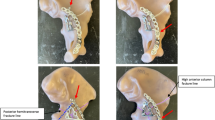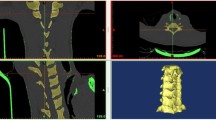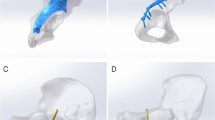Abstract
Purpose
Percutaneous pedicle screw (PPS) fixation has been commonly used for various spine surgeries. Rigid PPS fixation is necessary to decrease the incidence of screw loosening in osteoporotic spine. Recently, we have reported biomechanical advantages of augmentation technique using hydroxyapatite (HA) granules for PPS fixation in synthetic bone. However, its biomechanical performance in augmenting PPS fixation for osteoporotic spine has not been fully elucidated. The aim of the present study is to perform a cadaveric biomechanical analysis of PPS fixation augmented with HA granules.
Methods
Thirty osteoporotic lumbar vertebrae (L1–L5) were obtained from 6 cadavers (3 men and 3 women; age 80 ± 9 years; bone mineral density 73 ± 9 mg/cm3). The maximal pullout strength and maximal insertion torque were compared between the screws inserted into the vertebrae with and without augmentation. In toggle testing, the number of craniocaudal toggle cycles and maximal load required to achieve the 2-mm screw head displacement were also compared.
Results
The maximal pullout strength in the screws augmented with HA granules was significantly greater compared to those without augmentation (p < 0.05). The augmentation significantly increased the maximal insertion torque of the screws (p < 0.05). Moreover, the number of toggle cycles and the maximal load required to reach 2 mm of displacement were significantly higher in the augmented screws (p < 0.05).
Conclusion
The PPS fixation was significantly enhanced by the augmentation with HA granules in the osteoporotic lumbar spine. The PPS fixation augmented with HA granules might decrease the incidence of screw loosening and implant failure in patients with osteoporotic spine.








Similar content being viewed by others
References
Mobbs RJ, Sivabalan P, Li J (2011) Technique, challenges and indications for percutaneous pedicle screw fixation. J Clin Neurosci 18(6):741–749. https://doi.org/10.1016/j.jocn.2010.09.019
Zhang W, Li H, Zhou Y et al (2016) Minimally invasive posterior decompression combined with percutaneous pedicle screw fixation for the treatment of thoracolumbar fractures with neurological deficits. Spine 41:B23–B29. https://doi.org/10.1097/BRS.0000000000001814
Lehman RA, Kang DG, Wagner SC (2015) Management of osteoporosis in spine surgery. J Am Acad Orthop Surg 23(4):253–263. https://doi.org/10.5435/JAAOS-D-14-00042
Okuyama K, Abe E, Suzuki T et al (2000) Can insertional torque predict screw loosening and related failures? An in vivo study of pedicle screw fixation augmenting posterior lumbar interbody fusion. Spine 25(7):858–864
Okuyama K, Abe E, Suzuki T et al (2001) Influence of bone mineral density on pedicle screw fixation: a study of pedicle screw fixation augmenting posterior lumbar interbody fusion in elderly patients. Spine J 1(6):402–407
Foley KT, Holly LT, Schwender JD (2003) Minimally invasive lumbar fusion. Spine 28(15 Suppl):S26–35. https://doi.org/10.1097/01.BRS.0000076895.52418.5E
Kuklo TR, Dmitriev AE, Cardoso MJ et al (2008) Biomechanical contribution of transverse connectors to segmental stability following long segment instrumentation with thoracic pedicle screws. Spine 33(15):E482–487. https://doi.org/10.1097/BRS.0b013e31817c64d5
Ohba T, Ebata S, Oba H et al (2019) Risk factors for clinically relevant loosening of percutaneous pedicle screws. Spine Surg Relat Res 3(1):79–85. https://doi.org/10.22603/ssrr.2018-0018
Park Y, Seok S-O, Lee S-B et al (2018) Minimally invasive lumbar spinal fusion is more effective than open fusion: a meta-analysis. Yonsei Med J 59(4):524–538. https://doi.org/10.3349/ymj.2018.59.4.524
Son S, Lee SG, Park CW et al (2012) Minimally invasive multilevel percutaneous pedicle screw fixation for lumbar spinal diseases. Korean J Spine 9(4):352–357. https://doi.org/10.14245/kjs.2012.9.4.352
Cho W, Cho SK, Wu C (2010) The biomechanics of pedicle screw-based instrumentation. J Bone Joint Surg Br 92(8):1061–1065. https://doi.org/10.1302/0301-620X.92B8.24237
Hongo M, Ilharreborde B, Gay RE et al (2009) Biomechanical evaluation of a new fixation device for the thoracic spine. Eur Spine J 18(8):1213–1219. https://doi.org/10.1007/s00586-009-0999-4
Murakami H, Tsai K-J, Attallah-Wasif ES et al (2006) A biomechanical assessment of infra-laminar hooks as an alternative to supra-laminar hooks in thoracolumbar fixation. Spine 31(9):967–971. https://doi.org/10.1097/01.brs.0000214932.49027.6a
Kanno H, Aizawa T, Hashimoto K et al (2019) Enhancing percutaneous pedicle screw fixation with hydroxyapatite granules: a biomechanical study using an osteoporotic bone model. PLoS ONE 14(9):e0223106. https://doi.org/10.1371/journal.pone.0223106
Furderer S, Scholten N, Coenen O et al (2011) In-vitro comparison of the pullout strength of 3 different thoracic screw fixation techniques. J Spinal Disord Tech 24(1):E6–10. https://doi.org/10.1097/BSD.0b013e3181d47f9f
Okuyama K, Sato K, Abe E et al (1993) Stability of transpedicle screwing for the osteoporotic spine: an in vitro study of the mechanical stability. Spine 18(15):2240–2245
Matsuzaki H, Tokuhashi Y, Wakabayashi K et al (2001) Effects of hydroxyapatite solid granule (HA Stick) on pedicle screwing for osteoporotic patients. Clin Orthop Surg 36:529–534
Koller H, Zenner J, Hitzl W et al (2013) The impact of a distal expansion mechanism added to a standard pedicle screw on pullout resistance. A Biomech Study Spine J 13(5):532–541. https://doi.org/10.1016/j.spinee.2013.01.038
Baluch DA, Patel AA, Lullo B et al (2014) Effect of physiological loads on cortical and traditional pedicle screw fixation. Spine 39(22):E1297–E1302. https://doi.org/10.1097/BRS.0000000000000553
Liu D, Zhang Y, Lei W et al (2014) Comparison of 2 kinds of pedicle screws in primary spinal instrumentation biomechanical and interfacial evaluations in sheep vertebrae in vitro. J Spinal Disord Tech 27(2):E72–E80. https://doi.org/10.1097/BSD.0b013e318299f4b1
Wang WT, Guo CH, Duan K et al (2019) Dual pitch titanium-coated pedicle screws improve initial and early fixation in a polyetheretherketone rod semi-rigid fixation system in sheep. Chin Med J (Engl) 132(21):2594–2600. https://doi.org/10.1097/CM9.0000000000000335
Jacobs JE, Boxt LM, Desjardins B et al (2006) ACR practice guideline for the performance and interpretation of cardiac computed tomography (CT). J Am Coll Radiol 3(9):677–685. https://doi.org/10.1016/j.jacr.2006.06.006
Wilke HJ, Kaiser D, Volkheimer D et al (2016) A pedicle screw system and a lamina hook system provide similar primary and long-term stability: a biomechanical in vitro study with quasi-static and dynamic loading conditions. Eur Spine J 25(9):2919–2928. https://doi.org/10.1007/s00586-016-4679-x
Kueny RA, Kolb JP, Lehmann W et al (2014) Influence of the screw augmentation technique and a diameter increase on pedicle screw fixation in the osteoporotic spine: pullout versus fatigue testing. Eur Spine J 23(10):2196–2202. https://doi.org/10.1007/s00586-014-3476-7
Hasegawa T, Inufusa A, Imai Y et al (2005) Hydroxyapatite-coating of pedicle screws improves resistance against pull-out force in the osteoporotic canine lumbar spine model: a pilot study. Spine J 5(3):239–243. https://doi.org/10.1016/j.spinee.2004.11.010
Spivak JM, Neuwirth MG, Labiak JJ et al (1994) Hydroxyapatite enhancement of posterior spinal instrumentation fixation. Spine 19(8):955–964
Shin SJ, Lee J-H, Lee JH (2017) Influence of hydroxyapatite stick on pedicle screw fixation in degenerative lumbar spine: biomechanical and radiologic study. Clin Spine Surg 30(6):E819–E826. https://doi.org/10.1097/BSD.0000000000000405
Becker S, Chavanne A, Spitaler R et al (2008) Assessment of different screw augmentation techniques and screw designs in osteoporotic spines. Eur Spine J 17(11):1462–1469. https://doi.org/10.1007/s00586-008-0769-8
Elder BD, Lo S-FL, Holmes C et al (2015) The biomechanics of pedicle screw augmentation with cement. Spine J 15(6):1432–1445. https://doi.org/10.1016/j.spinee.2015.03.016
Galbusera F, Volkheimer D, Reitmaier S et al (2015) Pedicle screw loosening: a clinically relevant complication? Eur Spine J 24(5):1005–1016. https://doi.org/10.1007/s00586-015-3768-6
Derincek A, Wu C, Mehbod A et al (2006) Biomechanical comparison of anatomic trajectory pedicle screw versus injectable calcium sulfate graft-augmented pedicle screw for salvage in cadaveric thoracic bone. J Spinal Disord Tech 19(4):286–291. https://doi.org/10.1097/01.bsd.0000211203.31244.a0
Wu Z-x, Gong F-t, Liu L et al (2012) A comparative study on screw loosening in osteoporotic lumbar spine fusion between expandable and conventional pedicle screws. Arch Orthop Trauma Surg 132(4):471–476. https://doi.org/10.1007/s00402-011-1439-6
Liebsch C, Zimmermann J, Graf N et al (2018) In vitro validation of a novel mechanical model for testing the anchorage capacity of pedicle screws using physiological load application. J Mech Behav Biomed Mater 77:578–585. https://doi.org/10.1016/j.jmbbm.2017.10.030
Acknowledgements
The authors thank Dr. Michio Hongo and Dr. Keitaro Matsukawa for useful discussion.
Author information
Authors and Affiliations
Corresponding author
Ethics declarations
Conflict of interest
The authors declare that they have no conflict of interest.
Additional information
Publisher's Note
Springer Nature remains neutral with regard to jurisdictional claims in published maps and institutional affiliations.
Rights and permissions
About this article
Cite this article
Kanno, H., Aizawa, T., Hashimoto, K. et al. Novel augmentation technique of percutaneous pedicle screw fixation using hydroxyapatite granules in the osteoporotic lumbar spine: a cadaveric biomechanical analysis. Eur Spine J 30, 71–78 (2021). https://doi.org/10.1007/s00586-020-06451-2
Received:
Revised:
Accepted:
Published:
Issue Date:
DOI: https://doi.org/10.1007/s00586-020-06451-2




